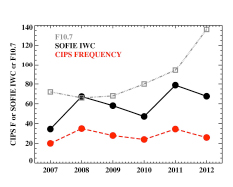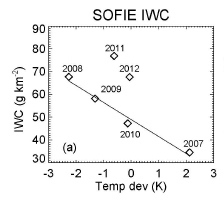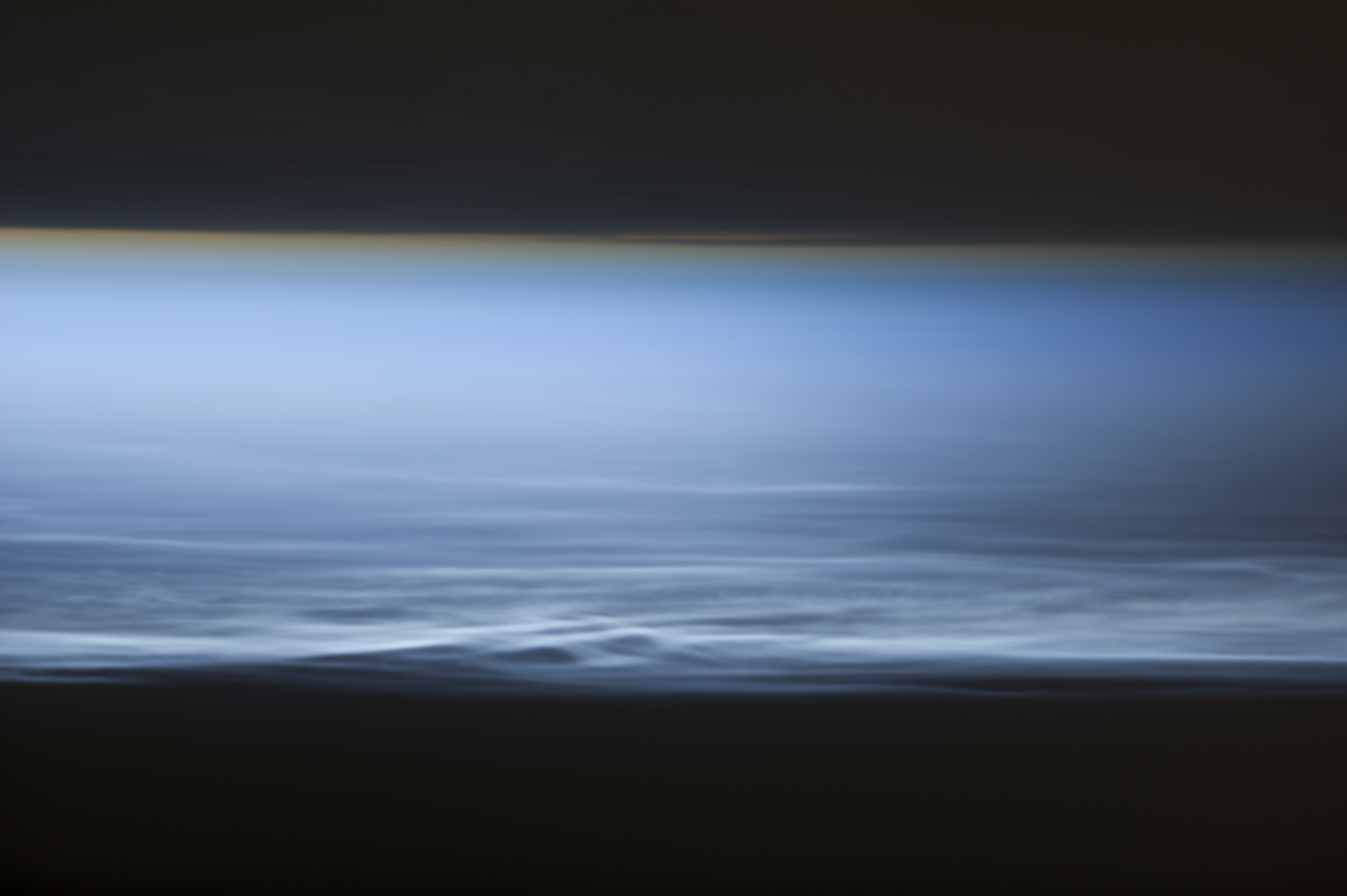
© U.S. Naval Research LaboratoryFigure 1. Variation of mid summer polar mesospheric clouds observed by two instruments on the NASA AIM satellite from 2007-2012. The Solar Occultation for Ice Experiment (SOFIE) measures ice water content (IWC) which is a proxy for cloud brightness; the Cloud Imaging and Particle Size Experiment (CIPS) records the frequency of occurrence. The quantity F10.7 is a proxy for solar activity which has increased since 2010.
Scientists at the U.S. Naval Research Laboratory (NRL) have determined that
there has been an increase in bright polar mesospheric clouds (PMCs) in the last two years, an unexpected result since these clouds are generally thought to be less prevalent during conditions of high solar activity which acts to destroy the tiny ice particles. Their research suggests that the man-made effect of water released by exhaust from
space traffic during recent years has overwhelmed the effect of higher solar activity. This research was published in the June 6, 2013, issue of
Geophysical Research Letters.This new understanding of weather at the edge of space serves to test high altitude weather and climate models of the upper atmosphere, including the co-located D&E-regions of the ionosphere which is critical for improving models of over-the-horizon-radar (OTHR) propagation, explains NRL's Dr. David Siskind, a scientist in NRL Space Science Division and principal investigator for the research.
Each summer, the Arctic and Antarctic atmospheres at very high altitudes (the upper mesosphere, 80 to 100 km) become extremely cold with temperatures well below -100°C, despite the presence of 24 hours of sunlight. These very low temperatures allow the atmosphere to become supersaturated, and enable thin, wispy ice clouds to condense on nuclei of meteoric dust and smoke particles. Because of the possibility that this region of the atmosphere may be changing due to man-made effects, NASA launched a dedicated satellite, the
Aeronomy of Ice in the Mesosphere (AIM) mission six years ago. Scientists used the AIM data to test atmospheric analyses provided by special high altitude prototype versions of the then-operational Navy Global Forecast System (NOGAPS). Previous studies by NRL scientists had shown this high altitude version of NOGAPS could demonstrate how variations in lower atmospheric weather conditions thousands of miles away might "teleconnect" to the Arctic and cause PMCs to vary.

© U.S. Naval Research LaboratoryFigure 2. The ice water content (IWC) from the SOFIE instrument on AIM shows that cloud brightness varied linearly with stratospheric temperatures (the x-axis is a measure of these temperatures) for the first 4 summers of the AIM mission. The excess cloud water content seen in 2011 and 2012 is clearly displayed. Based upon theories of solar cycle activity, IWC values of about 40 were expected for 2011 and 2012.
NRL scientists also believe that weather at the edge of space is sensitive to solar activity. An increase in the ultraviolet output of the sun can cause small temperature increases - NRL scientists expected these temperature increases to inhibit the formation of ice particles. In addition, increased ultraviolet light from the sun destroys water vapor molecules, making the already bone dry upper atmosphere even drier. Solar activity was unusually low for the first four years of the AIM mission, from 2007 to 2010, but has increased in the last two years.
Before the AIM mission, researchers estimated that the clouds should have decreased by 20 to 30% because of the high solar activity. Researchers were quite surprised to see that the occurrence of PMCs remained high and even increased (see figure 1). By studying the frequency and ice water content (IWC, which is a measure of cloud brightness) of the ice with weather conditions in the lower stratosphere, scientists see irregularities between the 2011 and 2012 measurements compared with measurements from the previous four years (see figure 2). Instead of 20 to 30% decreases, they saw up to 30% increases.

© Image Science and Analysis Laboratory, NASA-Johnson Space Center. "The Gateway to Astronaut Photography of Earth"Polar mesospheric clouds--also known as noctilucent, or "night shining" clouds--are formed above the Earth's surface near the mesosphere-thermosphere boundary of the atmosphere, a region known as the mesopause. This astronaut photograph was taken when the International Space Station was over the Pacific Ocean south of French Polynesia.
Researchers suggest that the explanation lies in a water vapor source from rocket exhaust. NRL scientists were the first to discover that individual PMCs could be formed by the exhaust from the space shuttle. Those earlier studies also suggested that these effects might appear in the long-term PMC record.
The new results confirm that suggestion and also suggest that this effect can dwarf that from solar cycle variations. A record of H
2O injected into the upper atmosphere by space traffic over the six-year period from 2007 to 2012 shows low amounts from 2007 to 2010 and then large increases in 2011 to 2012, precisely what is needed to explain the inconsistent PMCs. NRL scientists are particularly interested in the 2012 anomaly because it occurred after the termination of the shuttle program. Thus the possibility that the space traffic contribution to PMCs may persist post-shuttle is one that will be of intense interest as new data is studied over the next several years.






there has been an increase in bright polar mesospheric clouds (PMCs) in the last two years, an unexpected result since these clouds are generally thought to be less prevalent during conditions of high solar activity which acts to destroy the tiny ice particles.
High solar activity? Who are you kidding?
These very low temperatures allow the atmosphere to become supersaturated, and enable thin, wispy ice clouds to condense on nuclei of meteoric dust and smoke particles.
Meteoric dust. Meteoric. Exactly. Nuff' said.
Researchers suggest that the explanation lies in a water vapor source from rocket exhaust.
More anthropogenic bull. Apparently we have enough shutles flying around to produce noctilucent clouds over the entire globe. And of course most of their exhaust goes directly into the atmosphere causing this. Sure. That's a clear cause and effect right? Bull.
NRL scientists are particularly interested in the 2012 anomaly because it occurred after the termination of the shuttle program. Thus the possibility that the space traffic contribution to PMCs may persist post-shuttle.
And there you "scientists" completely contradict and discredit your hypothesis.
May persist post-shuttle? How about coming to the logical conclusion that maybe you should look at other factors and variables affecting the mesosphere like freaking fireball and comet activity that is on an exponential increase instead of trying to cling to a already loose theory?
Nice job trying to fit the square peg into the round hole. I really commend you on that. It's quite an art that these scientists have developed - completely override logic and think of an explanation that fits your preconcieved notions and is in accordance with the general diskurs.